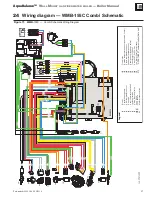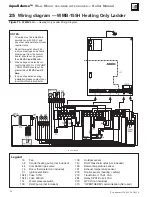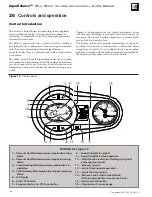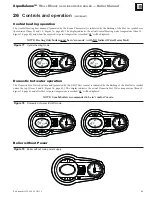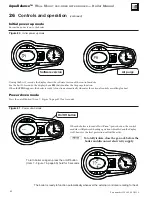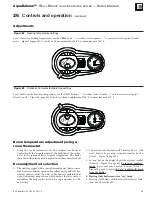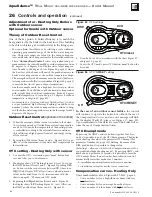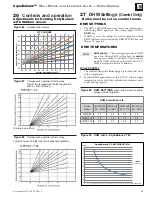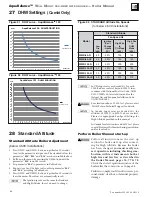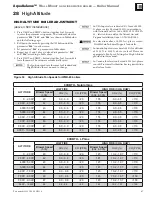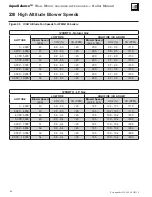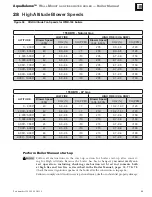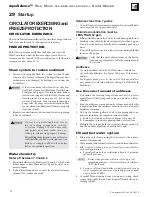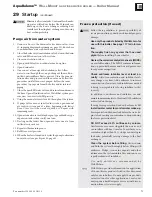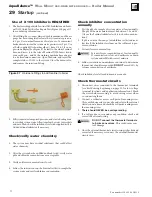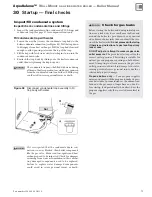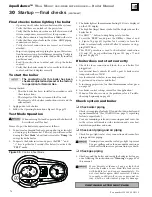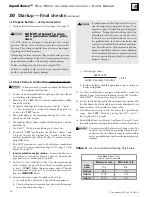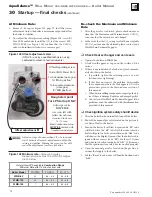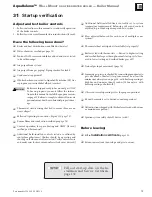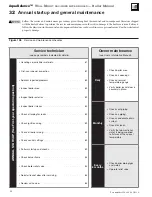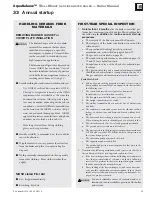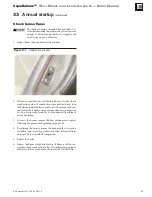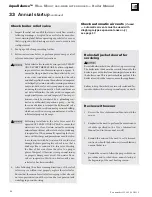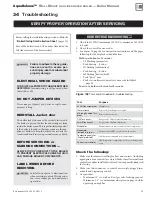
Freeze protection (if used)
Follow these guidelines to prevent possibility of
severe personal injury, death or substantial property
damage:
Use only the products listed by Weil-McLain for
use with this boiler. See page 117 for informa-
tion.
Thoroughly flush any system that has used
glycol
before installing the new boiler.
Review the material safety data sheets (MSDS)
are available online. The MSDS contains informa-
tion on potential hazards and first aid procedures
for exposure or ingestion.
Check antifreeze inhibitor level at least an-
nually
. Glycol concentration and inhibitor levels
may change over time. Add antifreeze to increase
concentration if necessary. Add inhibitor as needed
to bring to acceptable level, using inhibitor test kit
to verify.
In addition to antifreeze and inhibitor, use and
maintain minimum level of Sentinel X100 inhibitor
as directed on this page.
If using freeze protection fluid with automatic fill,
install a water meter to monitor water make-up
.
Freeze protection fluid may leak before the water be-
gins to leak, causing concentration to drop, reducing
the freeze protection level.
DO NOT exceed 50% antifreeze by volume
.
Antifreeze moves more sluggishly than water and
can interfere with heat transfer. At antifreeze con-
centrations higher than 50%, sludge can develop in
the boiler, potentially causing damage to the heat
exchanger.
Clean the system before filling
. Always drain
and flush the system thoroughly before filling with
antifreeze. Sludge, iron oxide deposits and other
sediment in the system inhibit flow and can cause
rapid breakdown of inhibitors.
U s e o n l y a n t i f r e e z e r e c o m m e n d e d b y
Weil-McLain.
Weil-McLain provides information for application
of the antifreeze products listed in this document
only for use in boilers. Do not apply these products
or instructions for other applications. Local codes
may require a backflow preventer or actual discon-
nection from city water supply.
Part number 550-100-305/0118
71
AquaBalance
TM
W
ALL
M
OUNT
GAS
-
FIRED
WATER
BOILER
—
Boiler Manual
29
Startup
(continued)
Eliminate all system leaks. Continual fresh make-
up water will reduce boiler life. Minerals can
build up in the heat exchanger, reducing heat
transfer, overheating heat exchanger, and causing
heat exchanger failure.
Purge air from water system
1. Connect a hose to the drain valve (see drain valves, item
10, in piping diagrams beginning on page 11). Route hose
to an area where water can drain and be seen.
2. Close the boiler or system isolation valve between the drain
valve and fill connection to the system.
3. Close zone isolation valves.
4. Open quick-fill valve on cold water make-up line.
5. Open drain valve.
6. One zone at a time, open the isolation valves. Allow
water to run through the zone, pushing out the air. Run
until no noticeable air flow is present. Close the zone iso-
lation valves and proceed with the next zone. Follow this
procedure until all zones are purged. Follow the same
procedure to purge air from the boiler and its internal
piping.
7. Close the quick-fill water valve and drain valve and remove
the hose. Open all isolation valves. Watch that system pres-
sure rises to correct cold-fill pressure.
8. Using the manual air vents located throughout the system.
9. If purge valves are not installed in system, open manual
air vents in system one at a time, beginning with lowest
floor. Close vent when water squirts out. Repeat with
remaining vents.
10. Open automatic air vent (diaphragm-type or bladder-type
expansion tank systems only) one turn.
11. Starting on the lowest floor, open air vents one at a time
until water squirts out.
12. Repeat with remaining vents.
13. Refill to correct pressure.
14. When the boiler is turned on it cycles the pump to eliminate
any air in system, per Figure 80, page 62.

